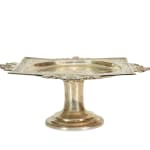Salva ("Tazza") de pé / A Footed Dish (Tazze), Portugal, séc. XVI
prata / silver
10,0 x 26,5 x 26,5 cm
B305
Further images
Shallow dishes or low footed bowls, known in Italy as tazza and designed for presenting foodstuffs on the dining table were, similarly to those from Renaissance Venice, made in glass or in precious metals. It is likely that the latter tazze supplied the glass makers with models from which the glass versions were made. European paintings, dating from the 16th and 17th centuries, provide numerous images of how these glass and often silver dishes, were used for serving wine or dressed for displaying a variety of delicacies or sweetmeats, such as biscuits and candied of fresh fruits. Known in Portugal as salvas, they were destined for tasting wines or foods for poison.The present example, probably destined for serving delicacies or fruit, would have been put on display when not in use. Of unusual, squared dish, it is a rare survival of Portuguese Mannerist display silver dating from the second half of the 16th century. Finely chased, its typically Mannerist rolls (cuir) and ferroneries decoration on punctured ground, as well as its cast lion masks set within cartouches, were possibly modelled after contemporary printed sources. It comprises of a turned, moulded foot that screws up onto the square dish of circular turned cavetto, by a thick screw-thread.It features Lisbon’s assay-marks (L – 14A), alongside the maker’s mark ‘fa’ (L–217A) for an unidentified silversmith working in the second half of the 16th century. Apart from these marks, there are also two later monograms, probably ownership marks dating from the 19th century (‘vm’ and ‘ej’), engraved onto the recessed circular cavetto. On the dish’s underside, a longer handwritten inscription, scratched onto the silver and difficult to interpret.The assay-marks, for testing the silver purity grade, probably punched when the dish was made or when it was sold, are also evident in the dish’s underside and in the foot. An important testimony of late-16th century Portuguese silverwork the present dish was displayed at the 2007 exhibition A Ourivesaria Portuguesa e os seus Mestresat the Museu Nacional Soares dos Reis, Oporto.
Provenance
José Sanina, PortugalExhibitions
A Ourivesaria Portuguesa e os seus Mestres, Porto, 2002Join our mailing list
* denotes required fields
We will process the personal data you have supplied in accordance with our privacy policy (available on request). You can unsubscribe or change your preferences at any time by clicking the link in our emails.









